Do you want to learn how to play BM on Piano? If so, you've come to the right place!
The Bm chord, also known as B minor, is one of the most played chords in various music styles.
Playing this piano music chord can take your skills to the next level. It can add depth and emotion to your playing.
In this blog post, I'll explain how the Bm chord is built and how to play it on a piano. This lesson covers everything from finger placements to inversions so you can play this chord with confidence and control.
By the end of this article, you'll be able to play the Bm piano chord confidently.
So, let's get started!
What is a B Minor Chord (Bm) On Piano
A B minor chord combines three notes: B, D, and F#. These notes are called the root note (B), a minor third (D), and a perfect fifth (F#). This piano chord is also known as a "B minor triad." It is written as B minor, Bmin, or Bm.
Like any other minor triad, you'll need to combine the root, minor third (flat third), and perfect fifth of the B major scale to create a B minor chord.
Let's look at the B major scale!
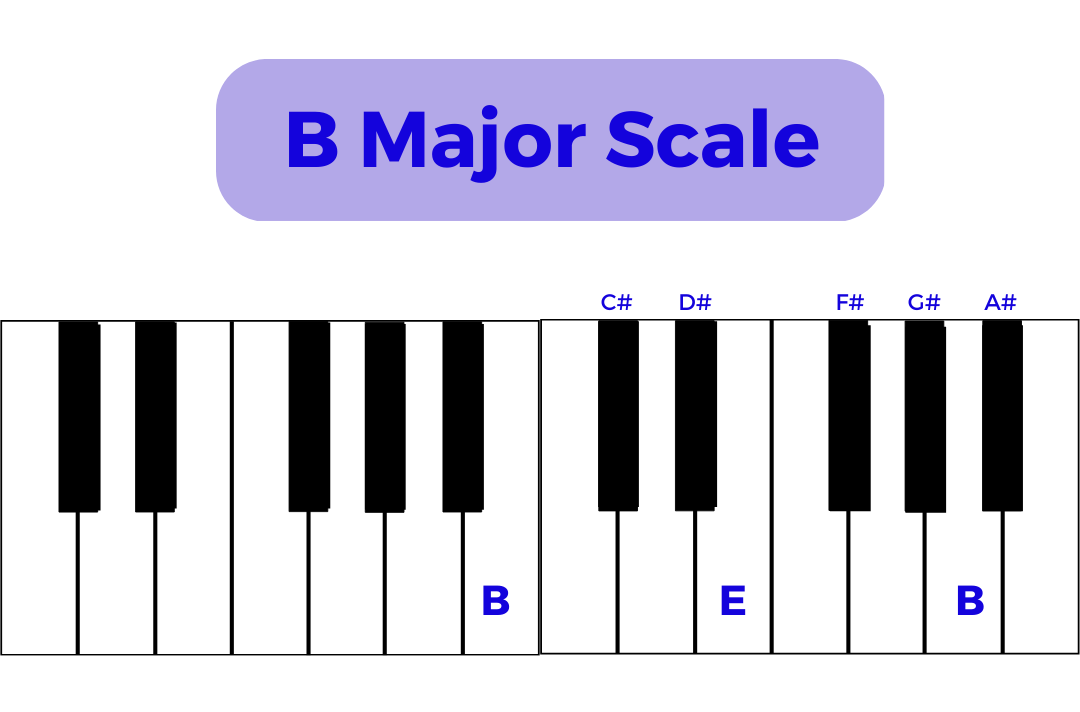
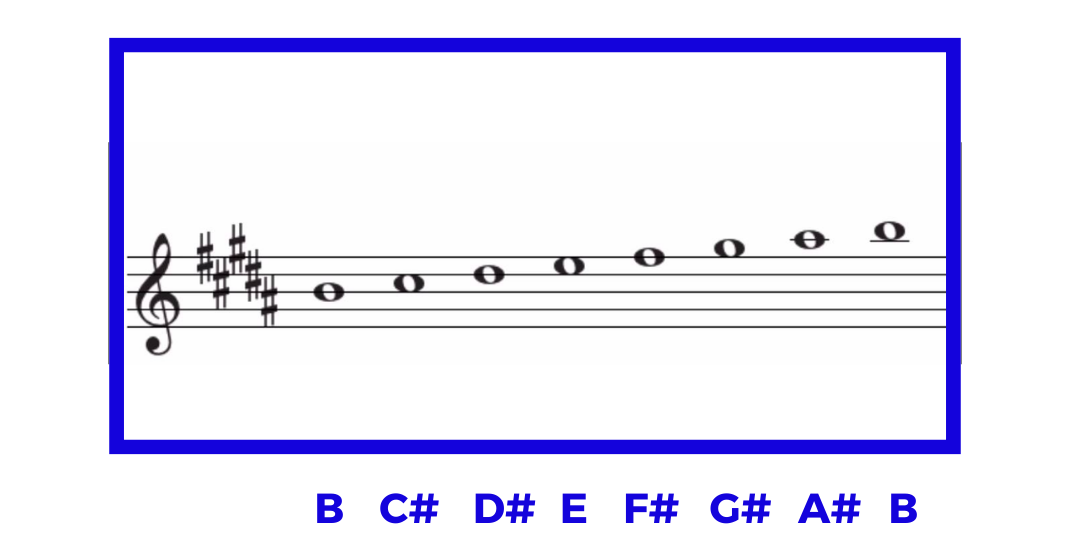
The B major scale consists of the notes B, C#, D#, E, F#, G#, A#, and B. In this scale, B is the tonic or root, C# is the major second, D# is the major third, E is the perfect fourth, F# is the perfect fifth, G# is the major sixth, A# is the major seventh, and B is the perfect eighth.
To form a B minor chord, you must play the third note of the scale (D#) a semitone lower, so you play D instead of D#. D represents the minor third, while D# represents the major third.
As a result, the notes of a B minor chord are the root (B), the minor third (D), and the perfect fifth (F#).
B – D – F#
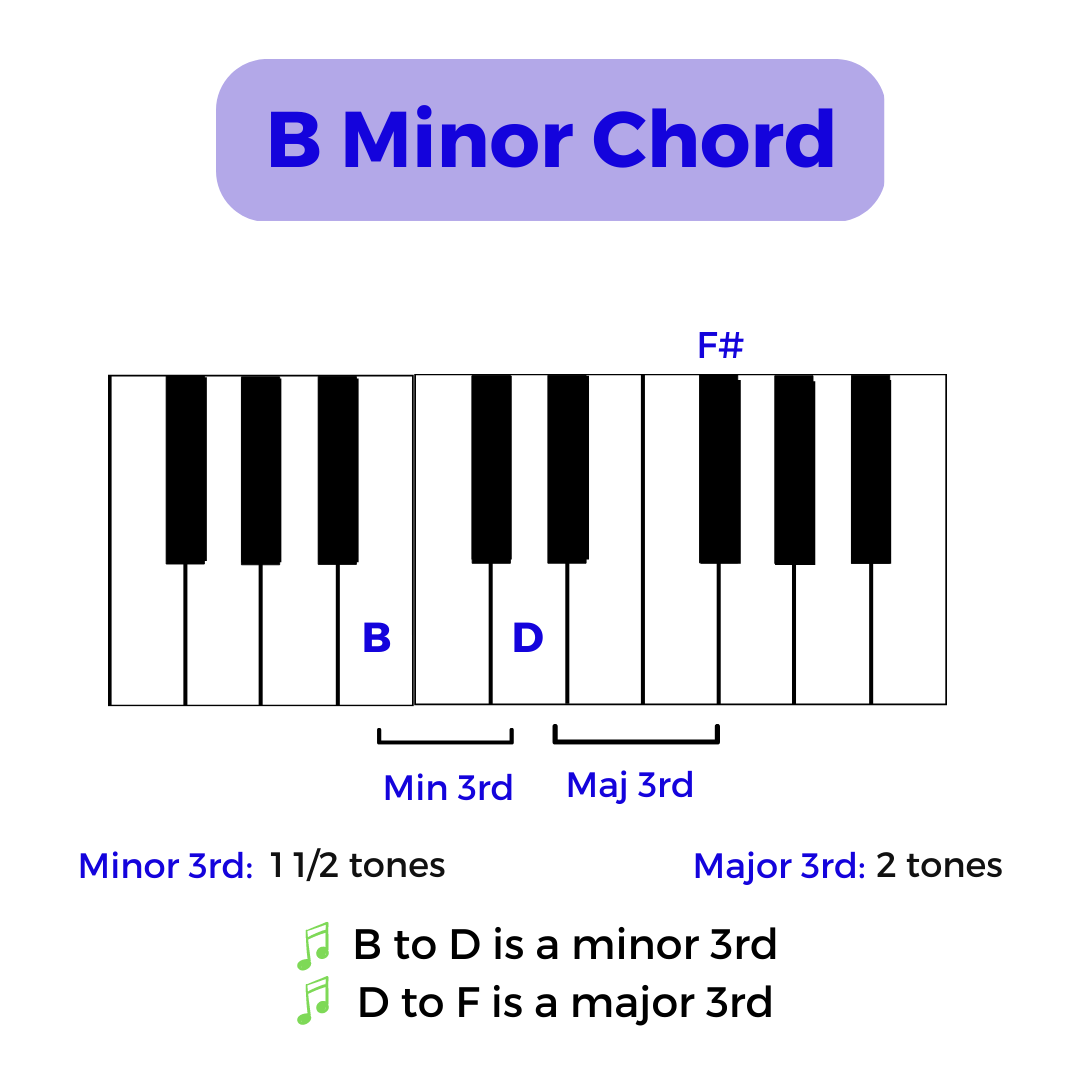
Note: If you already know how to play the B major chord, you only need to lower the middle note D# by a half step to make a B minor chord. In simple terms, replace D# with D.
Minor Chord Formula
Alternatively, you can use the formula of half steps to build a B minor chord.
The Formula of Half Steps – R + 3HS + 4HS
Here, the "R" stands for the chord's root, the 3HS for three half steps, and the 4HS for four half steps.
In addition to the Bm piano chord, you can form almost all minor chords on your piano keyboard using this formula of half steps.
Here's how you can build a B minor chord using half steps:
First, locate the note B on your piano keyboard to create a B minor chord. You can find the B key right after the group of three black keys.
After you've located B, move three-half steps higher to find D, and from D, move four steps higher to find F#. It will give you the notes B, D, and F#, which make up a B minor chord.
You will get a Bm chord if you press these three keys simultaneously.
How To Play Bm On Piano
Now that you know how a B minor chord form is, it's time to learn how to play it on a piano. You can play this chord on your piano keyboard in three ways:
Root Position – Where the B note is the lowest note of the chord.
First Inversion – In this case, the lowest note of the chord D.
Second Inversion – In this case, the lowest note of the chord is F#.
I'll explain this in some more detail with the images below. But before we get into that, let's first understand the finger positions for the B minor piano chord!
B Minor Chord Fingering
Piano chord fingering is an important aspect of playing the instrument. It involves placing your fingers on the keys in a specific order to produce the desired chord. While there is no correct way to finger a chord, finding what feels comfortable and works best for you is essential.
If you're new to piano chords, the fingers on each hand are numbered from 1 to 5 in piano sheet music. Let's quickly discuss how your fingers are numbered!
As you can see in the image below, the thumb is finger number 1, the index finger is number 2, the middle finger is number 3, the ring finger is number 4, and the pinky (little) finger is finger number 5.

The right-hand finger positions are 1 - 3 - 5 in the root position of Bm. In other words, the thumb (finger 1) plays the B note, the middle finger (finger 3) plays D, and the little finger (finger 5) plays F#.
In the 1st inversion, the finger positions of the Bm chord are 1 - 2 - 5. That means the thumb plays D, the index finger (finger 2) plays F#, and the little finger plays B.
In the second inversion, the fingering of the Bm piano chord is 5 – 3 – 1. The pinky finger plays D, the middle finger plays B, and the thumb plays F#.
When we play the Bm chord on the piano, we typically use the first, third, and fifth fingers.
How To Play The B Minor Piano Chord In Its Root Position
Playing the Bm Chord in Its Root Position with the Right Hand
When playing the B minor piano chord in its root position with your right hand, use the following fingers:
- F# - Fifth finger (5)
- D - Third finger (3)
- B - First finger (1)
See the image below for the correct finger placements to play a B minor chord with the right hand:
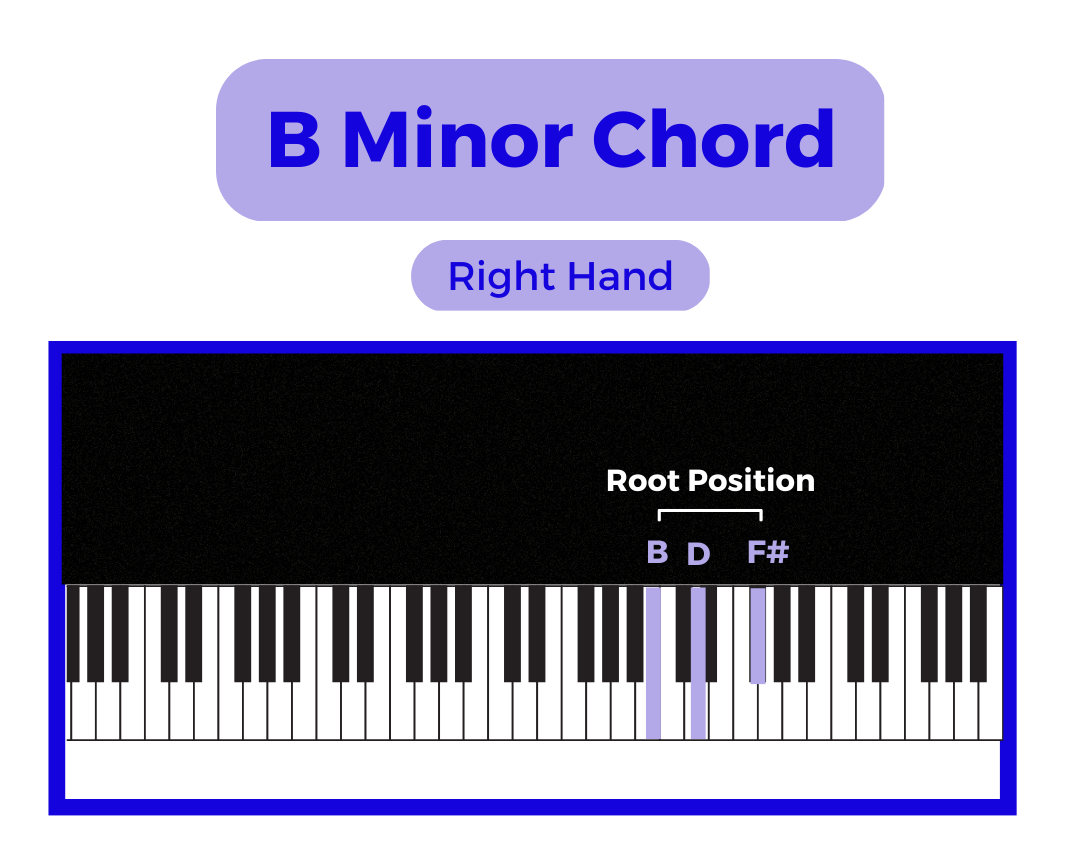
When you press all three notes, your piano will produce a beautiful chord (Bm).
Remember, your thumb and middle finger (1st and 3rd fingers) should play the white keys, while your pinky finger (5th finger) should play the black key.
Playing the Bm Chord in Its Root Position with the Left-Hand
To play the Bm root position chord with your left hand, use the following fingers:
- F# - First finger (1)
- D - Third finger (3)
- B - Fifth finger (5)
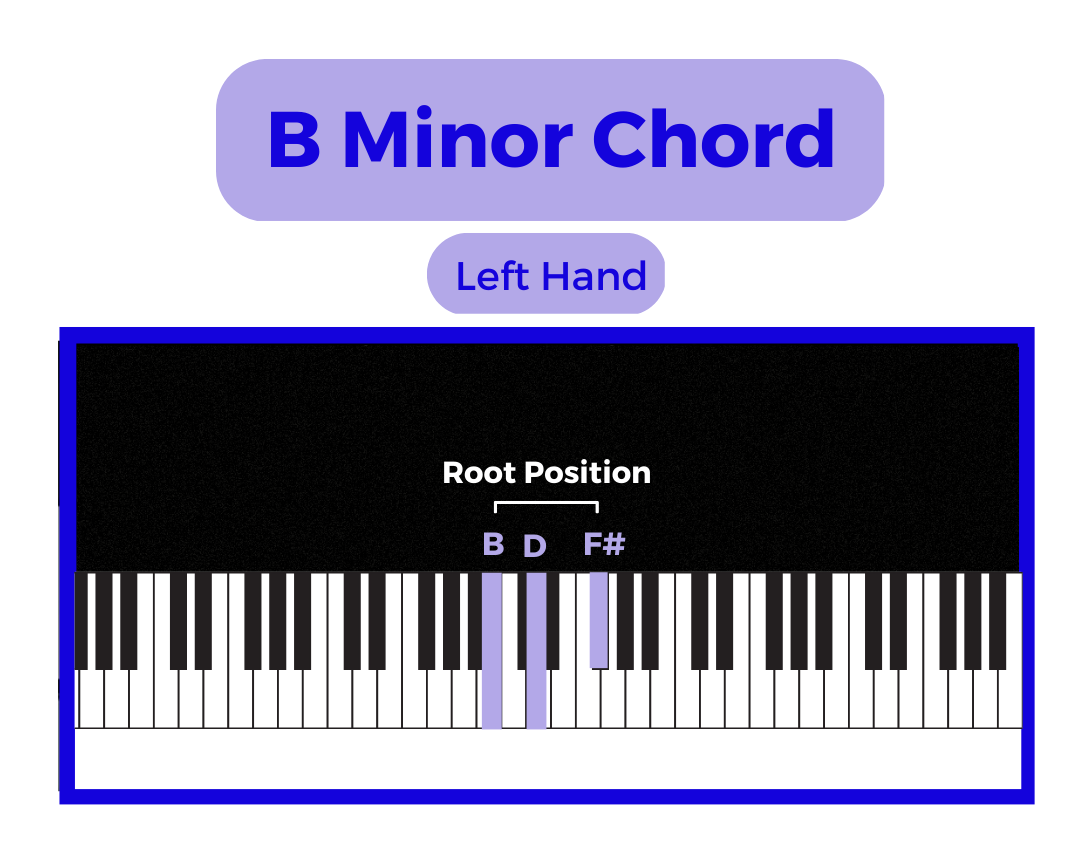
According to the piece of music you're playing, you might find it easier to play the B minor chord with different fingers.
In addition to its root position, the B minor chord has two inversions. Now let's take a look at the inversions of the Bm chord!
How To Play The 1st Inversion of Bm Piano Chord
The B minor chord is in its 1st inversion if you put the D as the lowest note in the chord. To play the piano chord with your right hand, you'll need to use the following fingers:
- B - Fifth finger (5)
- F# - Second finger (2)
- D - First finger (1)
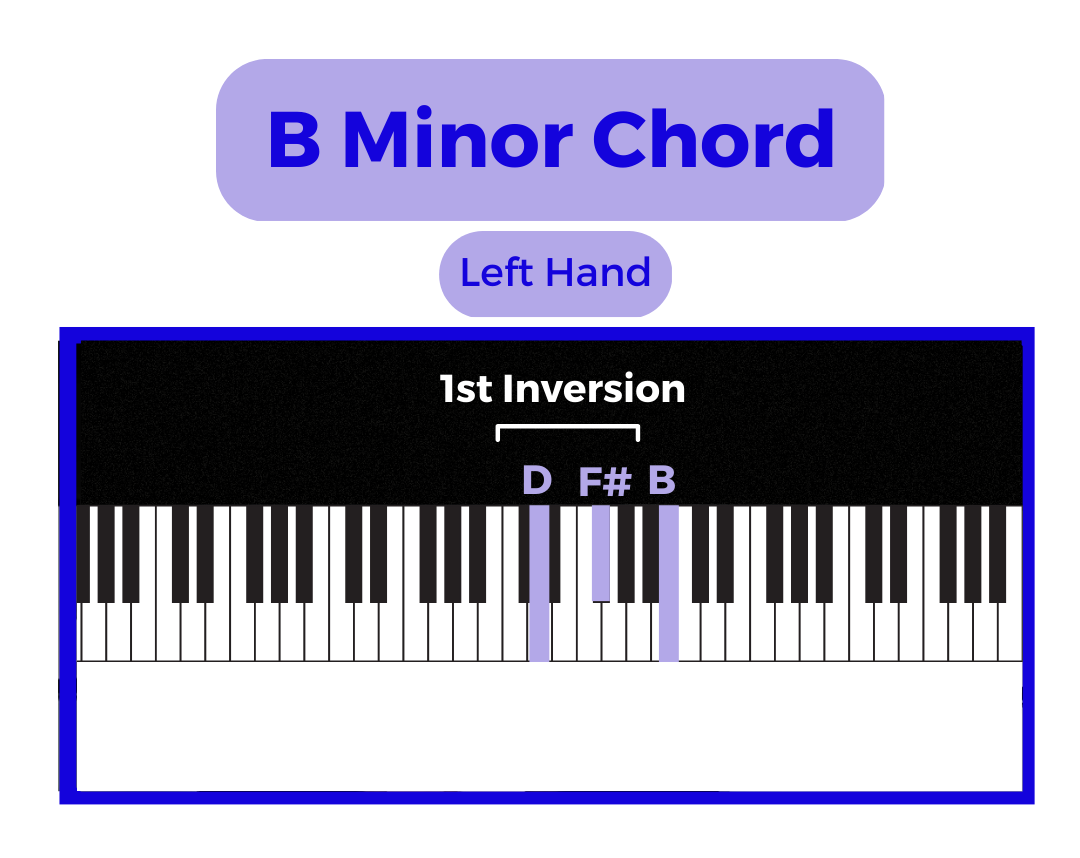
How To Play The 2nd Inversion of Bm Piano Chord
When you put the F# as the lowest note in the chord, the B minor is in the 2nd inversion. It is another variation of the Bm chord that can add variety to your playing.
If you want to play the second inversion of the Bm chord with your right hand, use the following fingers:
- D - Fifth finger (5)
- B - Third finger (3)
- F# - First finger (1)
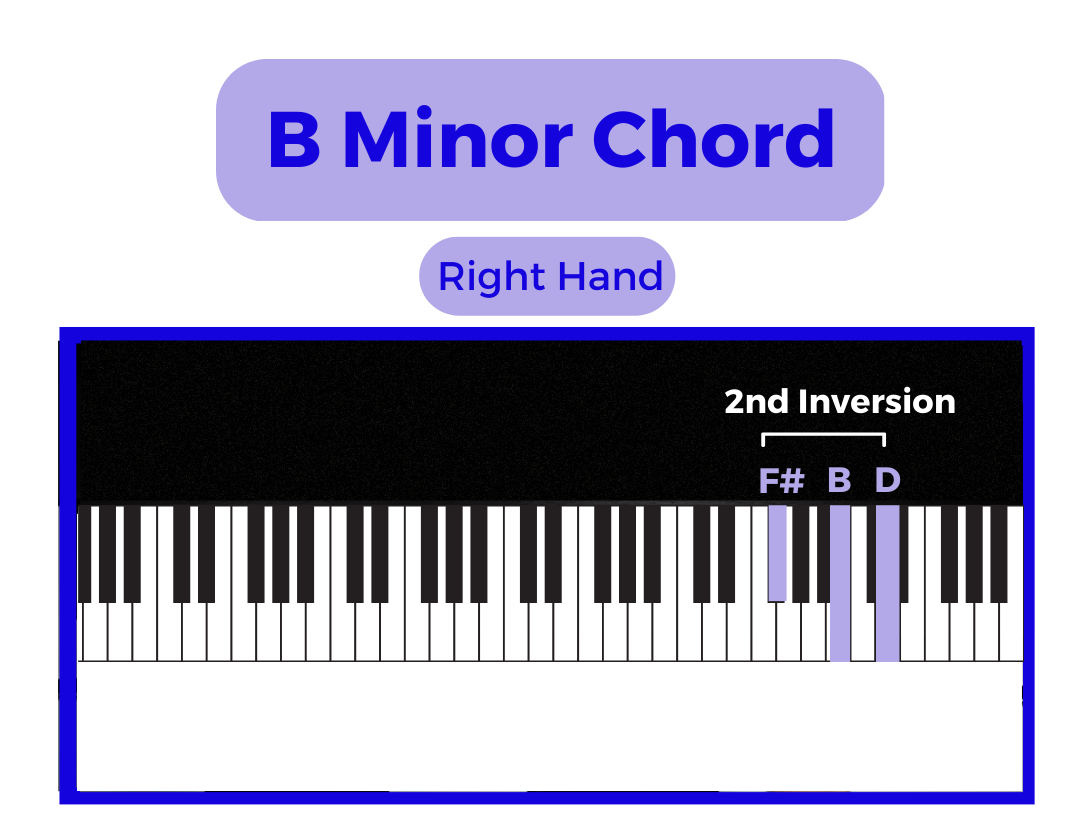
To play the second inversion of the Bm chord with your left hand, you should use the following fingers:
- F# - Fifth finger (5)
- B - Second finger (2)
- D - First finger (1)
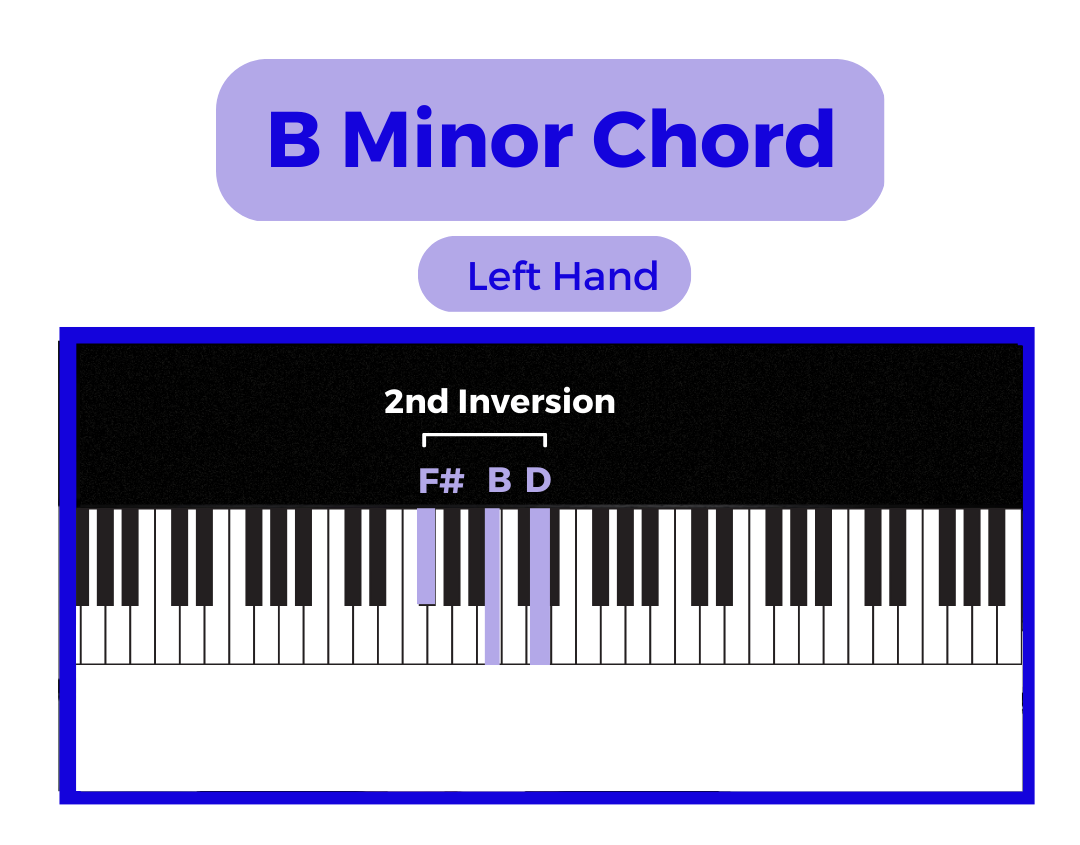
Place your fingers on the notes in the proper way and play them all at the same time. Now you can enjoy the sound of this minor piano chord in the second inversion.
Note: You can also watch this video that shows how to play the B minor chord in its root position and 1st and 2nd chord inversions.
FAQs
What Chord Goes Well With Bm?
Several chords can work well with Bm in a piano piece. Chords commonly used with Bm include Em (E minor), G major, C# diminished, F# minor, A major, and D major chord.
What Songs Use The Bm Chord On The Piano?
Many songs use the Bm chord on the piano. Some examples of popular songs that use Bm include:
- "Hey Jude" by The Beatles
- "Stand By Me" by Ben E. King
- "Don't Stop Believin'" by Journey
- "Let It Be" by The Beatles
- "Hallelujah" by Jeff Buckley
- "Summer of '69" by Bryan Adams
This is just a small selection of popular songs that use a Bm piano chord.
How Do I Incorporate The Bm Chord Into A Song?
To incorporate the Bm chord into a song, you will need to know the chord progression of the music. A chord progression is an order in which the chords are played in a song. Once you know the chord progression, you can insert the Bm chord wherever it appears.
Can I Play The Bm Chord With My Left Hand Instead of My Right Hand?
Yes, you can play the Bm chord with either your right hand or your left hand on the piano. To play it with your left hand, follow the exact finger placement described above, but use your left hand instead of your right hand.
Conclusion
Learning how to play the basic triad chords on a piano is one of the fundamental methods to improve your piano skills.
The B minor (Bm) piano chord consists of the notes B, D, and F#. When you play Bm on the piano, you might find it challenging but rewarding.
After learning the basics of B minor chord notes, you can experiment with different techniques and styles to find what works best for you.
Whether you prefer to play with two hands or just one, in root position or first inversion, the important thing is to have fun and let your creativity shine.
Practice and patience are key to mastering any skill, so don't be discouraged if it takes some time to get the hang of it.
So grab your keyboard piano and start exploring the world of a B minor chord!
Harlan Kilstein began playing piano during covid with no piano background at all. He taught himself how to play learning what to do and what not to do.
Today he's an advanced intermediate player and can help you grow in your skills because he learned all this on his own.








